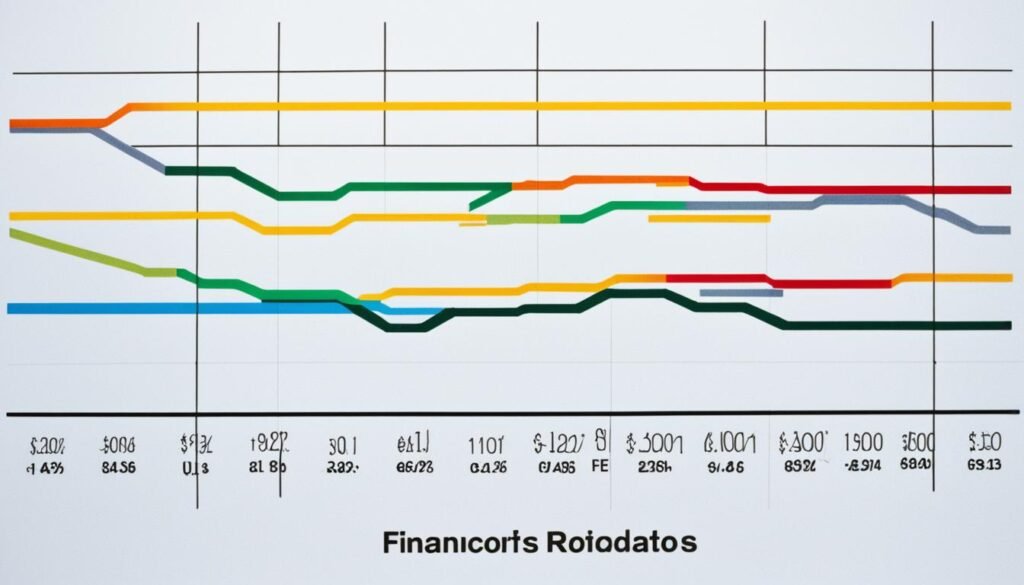When you buy a stocks, you’re getting a slice of a company. It lets you share in its wins or losses over time. Picking a stock needs careful thought and time. You should seek answers to key questions and use proven methods to evaluate it. This helps determine if the stock is a good fit for you.
Evaluating a stock means looking at many things. You check the company’s finances, leadership, and its place among competitors. It also means looking at possible risks. Mixing both numbers and other info helps you make better choices. But, keep in mind, investing in stocks is for the long haul. Always think about how a stock fits with your bigger investing plan and how much risk you’re okay with.
Key Takeaways
- Buying a stock means owning a share of a company and participating in its success or failure over time.
- Thorough research and evaluation of a company’s operations, finances, industry, and risks are crucial before investing.
- Analyzing key financial ratios, such as P/E, P/S, and D/E, can provide valuable insights into a stock’s valuation.
- Utilizing reputable research resources, including FINRA’s Market Data Center and professional analyst reports, can enhance the investment decision-making process.
- A comprehensive approach, considering both quantitative and qualitative factors, is essential for making informed stock investment decisions.
Answering Key Questions About the Company
It’s important to look closely at a company’s activities, finances, as well as the dangers it meets in the market and the economy. By asking important questions about these areas, investors can get key details. These details help make wise choices when picking stocks.
Understanding the Company’s Operations
Want to know how a company runs? Ask yourself: How does it make money? Are people wanting what it sells, and why? How well has the company done before now? Are smart, skilled managers leading it? Is it set to grow and make a profit?
Also Read: How Can I Calculate Capital Gains On Real Estate Investments?
Evaluating the Company’s Finances
For the financial side, check how much debt it has. You’ll find this in the company’s paperwork, like the balance sheet and income statement. These are in documents the company files with the SEC, such as the 10-Q and 10-K.
Assessing Industry and Economic Risks
To see the industry and economic hazards the company might face, consider this: How is its industry overall? What are the big challenges? Are there risks from the economic, politics, or culture?
Analyzing Key Financial Ratios

Earnings per Share (EPS)
Also Read: Top 9 Technology Trend You Must Keep An Eye On
Earnings per share (EPS) shows how profitable a company is. It’s found by dividing a company’s earnings by the number of its common shares. High EPS means the company is making good profits for its shareholders.
Price-to-Earnings Ratio (P/E)
The P/E ratio compares a company’s stock price to its EPS. It tells you how much people are willing to犀利士5mg
pay for the company’s earnings. A low P/E could mean the stock is a bargain, while a high P/E might mean the stock is expensive.
Price-to-Sales Ratio (P/S)
The P/S ratio looks at the company’s value based on its sales. It’s found by dividing the market value by the total sales. This can be helpful for looking at newer companies that aren’t profitable yet.
Debt-to-Equity Ratio (D/E)
The D/E ratio shows how much a company relies on debts versus its equity. A high ratio could mean the company is taking on a lot of risk to grow.
By studying these ratios, investors get a clearer picture of a company’s health and its value as an investment. This helps them make better decisions when choosing stocks.
Also Read: How Secure Is Domain Hosting?
Utilizing Stock Research Resources

Investors have many resources for stock research. They can access market data and professional insights. These tools help them make smart choices.
FINRA’s Market Data Center
FINRA’s Market Data Center is for everyone. It has detailed info on stocks. Including company profiles, financial ratios, and real-time data. It helps investors understand companies better.
Professional Stock Research
Brokerage firms offer stock research too. Their analysts and industry experts share their insights. This helps investors get a full picture of a company. They learn about its strengths, weaknesses, and future prospects.
Also Read: How Can I Manage My VPS Hosting Server?
Independent Research and Consensus Reports
It’s also good to look at independent sources. Analysts not linked to a specific firm give unbiased views. Consensus reports show what many experts think. But, be careful with social media or forums. Information there might not be accurate or reliable.
Price-to-Book (P/B) Ratio

The price-to-book (P/B) ratio compares a company’s market value to its book value. This book value shows the worth of the company’s assets if they were sold. The P/B ratio is very useful for people who are careful with their investments. It gives a quick look at a company’s actual value.
If a company’s P/B ratio is low, under 1.0, it might be a sign that its stock is undervalued. But, a low P/B ratio might also show that the company is having trouble. Investors who are careful use this ratio to check if a stock is worth buying.
Learning about the price-to-book ratio can help investors understand how a company’s stock is valued. This knowledge can lead to smarter decisions about buying stocks that are likely to be good investments.
Also Read: Exploring the Role of Artificial Intelligence in Education
Price-to-Earnings Growth (PEG) Ratio

The price-to-earnings growth ratio (PEG) helps us see a company’s future. It looks beyond the price-to-earnings (P/E) ratio. It shows a company’s expected earnings growth too. This tells investors not just the stock’s current value. They also learn about its future growth potential.
Calculating the PEG ratio is easy. You divide the P/E ratio by the firm’s expected annual earnings growth rate. If the PEG ratio is under 1, the stock might be cheap. This means the stock price doesn’t match the company’s earnings growth. However, a PEG ratio over 1 suggests the stock could be too pricey.
The PEG ratio gives a fuller picture. It merges the current value with future earnings growth prospects. Investors often look at this ratio for growth stocks. These are stocks focused on increasing future growth and creating more value for their shareholders over time.
Dividend Yield
Dividend yield tells you how much money you might get in dividends for each dollar you put into a company’s stock. It’s great for people who like to get income from their investments. But, a high dividend yield might also mean the company is not doing well and its stock price is dropping.
High-Yield Traps
At times, companies will stop or cut their dividends when they face money problems or when the economy is down. To be safe, investors need to make sure a company regularly pays out a certain portion of its earnings and has been making money steadily.
Dividend Stability
When looking at dividend stability, focus on firms that have kept up or even raised their dividends over time. Even in hard times, this shows they’re strong financially and care about their investors getting rewarded.
Growth Limitations
Companies paying big dividends have less money to grow their business further. So, their stock prices might not go up as much over time as companies using their profits to grow their business. This can potentially limit how much the stock price might increase.
Stocks Valuation: A Comprehensive Approach

Looking at a stock means looking at the company’s numbers and qualities. The numbers part checks the financial statements and ratios. The qualities part looks at things like the company’s competitive advantage and its leadership.
Quantitative and Qualitative Analysis
For qualitative research, focus on what sets the company apart. This could be its strong brand or its unique innovations. Or, even its unmatched business model. Look at what gives it an edge over others.
Competitive Advantage Assessment
Consider the skills of the management team and board of directors. It’s key to see their past choices and how smart they are. Also, see if the board acts independent and fair.
Management and Board Evaluation
Think about possible problems that might hurt the company’s future. For example, an important patent ending or a strong new competitor. Even the rise of new tech that might change things.
Identifying Potential Risks
Putting Stock Research into Context
Looking at a company’s historical performance helps us understand its resilience in challenges. It also shows how well it has improved and created shareholder value over time. Understanding a stock’s historical trends gives us a peek into its journey and future.
Industry and Peer Comparison
It’s vital to compare a company to its industry averages and competitors. This lets us see where it stands. Brokers offer tools like stock screeners for these checks. They help us quickly match up financial data and decide how a company is doing compared to others.
Utilizing Broker Research Tools
Brokers have lots of research tools and resources on their sites. You can find things like stock screeners and financial data there. These tools are great for digging up trends, checking how companies are doing, and making smart choices in investing.
Also Read: Explore New Possibilities With A Degree In Finance
Conclusion
Evaluating stock research means looking closely at a company’s finances, leadership, and competition. It is a mix of numbers and gut feelings. This helps investors pick better stocks for their portfolio.
Yet, stock investing is a marathon, not a sprint. It’s crucial to think long and hard about a stock’s place in your investment strategy. Being patient, careful, and disciplined are vital in the ever-changing stock market.
In the end, good stock research lays the groundwork for wise investment choices. By carefully looking at what affects a company’s success, investors create a portfolio ready for ups and downs. This approach aims for steady growth over the years.
FAQs
Q: What is the stock market?
A: The stock market is where buying and selling of shares of publicly-held companies occur, providing a platform for investors to participate in the financial markets.
Q: How can I evaluate stocks before investing?
A: Before investing in stocks, you should consider factors such as the company’s financial health, market trends, industry performance, and future growth potential.
Q: What is the significance of NASDAQ in stock trading?
A: NASDAQ is a stock exchange known for listing many technology companies and is a key platform for trading technology-based stocks.
Q: What are the types of stocks available for investment?
A: Common types of stocks include growth stocks, value stocks, income stocks, and cyclical stocks, each representing different investment strategies.
Q: How does the jobs report affect the stock market?
A: The jobs report, which indicates the employment situation in the economy, can impact investor sentiment, influencing stock prices and market expectations.
Q: What are some tools to help investors in evaluating stocks?
A: Investors can use tools like stock quotes, market capitalization data, real-time news updates, and stock analysis software to make informed investment decisions.
Q: What factors should I consider before buying or selling stocks?
A: Factors to consider include the company’s financial performance, market conditions, valuation metrics, long-term prospects, and your investment goals and risk tolerance.








